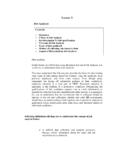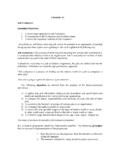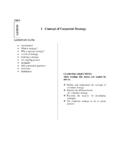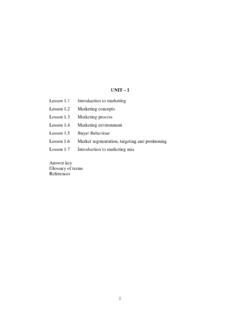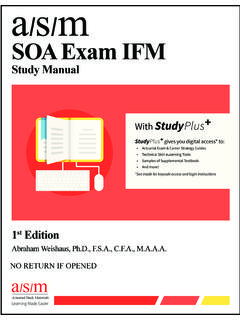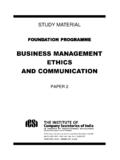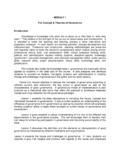Transcription of LESSON 27: MUTUAL FUNDS: AN INTRODUCTION
1 Copy Right: Rai OF FINANCIAL SERVICESL esson Objectives To understand the concept of MUTUAL funds, Its development in India and MUTUAL fund MUTUAL fund is a financial intermediary that pools the savingsof investors for collective investment in a diversified portfolioof securities. A fund is MUTUAL as all of its returns, minus itsexpenses, are shared by the fund s Securities and Exchange Board of India ( MUTUAL Funds)Regulations, 1996 defines a MUTUAL fund as a a fund estab-lished in the form of a trust to raise money through the sale ofunits to the public or a section of the public under one or moreschemes for investing in securities, including money marketinstruments .According to the above definition, a MUTUAL fund in India canraise resources through sale of units to the public. It can be setup in the form of a Trust under the Indian Trust Act. Thedefinition has been further extended by allowing MUTUAL fundsto diversify their activities in the following areas: Portfolio management services Management of offshore funds Providing advice to offshore funds Management of pension or provident funds Management of venture capital funds Management of money market funds Management of real estate fundsA MUTUAL fund serves as a link between the investor and thesecurities market by mobilising savings from the investors andinvesting them in the securities market to generate , a MUTUAL fund is akin to portfolio management services(PMS).
2 Although, both are conceptually same, they are differentfrom each other. Portfolio management services are offered tohigh net worth individuals; taking into account their risk profile,their investments are managed separately. In the case of mutualfunds, savings of small investors are pooled under a schemeand the returns are distributed in the same proportion in whichthe investments are made by the fund is a collective savings scheme. MUTUAL funds playan important role in mobilising the savings of small investorsand channelising the same for productive ventures in the of MUTUAL FundsAn investor can invest directly in individual securities orindirectly through a financial intermediary. Globally, mutualfunds have established themselves as the means of investmentfor the retail management: An average investor lacks theknowledge of capital market operations and does not havelarge resources to reap the benefits of investment.
3 Hence, herequires the help of an expert. It, is not only expensive to hire the services of an expert but it is more difficult toidentify a real expert. MUTUAL funds are managed byprofessional managers who have the requisite skills andexperience to analyse the performance and prospects ofcompanies. They make possible an organised investmentstrategy, which is hardly possible for an individual diversification: An investor undertakes risk ifhe invests all his funds in a single scrip. MUTUAL funds investin a number of companies across various industries andsectors. This diversification reduces the riskiness of in transaction costs: Compared to directinvesting in the capital market, investing through the fundsis relatively less expensive as the benefit of economies ofscale is passed on to the : Often, investors cannot sell the securities heldeasily, while in case of MUTUAL funds, they can easily encashtheir investment by selling their units to the fund if it is anopen-ended scheme orselling them on a stock exchange ifit is a close-ended : Investing in MUTUAL fund reducespaperwork, saves time and makes investment : MUTUAL funds offer a family of schemes, andinvestors have the option of transferring their holdingsfrom one scheme to the benefits MUTUAL fund investors now enjoy income-taxbenefits.
4 Dividends received from mutualfunds debtschemes are tax exempt to the overall limit of Rs 9,000allowed under section 80L of theIncome Tax MUTUAL funds transparently declare theirportfolio every month. Thus an investor knowswherehis/her money is being deployed and in case they are nothappy with the portfolio they canwithdraw at a short to the stock market MUTUAL funds have a largeamount of funds which provide them economies of scaleby which they can absorb any losses in the stock market andcontinue investing in the stock market. In addition, mutualfunds increase liquidity in the money and capital research MUTUAL funds can afford information anddata required for investments as they have large amount offunds and equity research teams available with of MUTUAL FundsThe history of MUTUAL funds, dates back to 19th centuryEurope, in particular, Great Britain. Robert Fleming set up in1868 the first investment trust called Foreign and ColonialLESSON 27: MUTUAL FUNDS: AN Copy Right: Rai UniversityMANAGEMENT OF FINANCIAL SERVICESI nvestment Trust which promised to manage the finances ofthe moneyed classes of Scotland by spreading the investmentover a number of different stocks.
5 This investment trust andother investment trusts which were subsequently set up inBritain and the US, resembled today s close-ended mutualfunds. The first MUTUAL fund in the US, Massachusetts Inves-tors Trust, was setup in March 1924. This was the firstopen-ended MUTUAL stock market crash in 1929, the Great Depression, and theoutbreak of the Second World War slackened the pace ofgrowth of the MUTUAL fund industry. Innovations in productsand services increased the popularity of MUTUAL funds in the1950s and 1960s. The first international stock MUTUAL fund wasintroduced in the US in 1940. In 1976, the first tax-exemptmunicipal bond funds emerged and in 1979, the first moneymarket MUTUAL funds were created. The latest additions are theinternational bond fund in 1986 and arm funds in 1990. Thisindustry witnessed substantial growth in the eighties andnineties when there was a significant increase in the number ofmutual funds, schemes, assets, and shareholders.
6 In the US, themutual fund industry registered a ten fold growth in theeighties (1980-89) only, with 25% of the household sector sinvestment in financial assets made through them. fund assetsincreased from less than $150 billion in 1980 to over $4 trillionby the end of 1997. Since 1996, MUTUAL fund assets haveexceeded bank deposits. The MUTUAL fund industry and thebanking industry virtually rival each other in of MUTUAL Funds in IndiaThe Indian MUTUAL fund industry has evolved over distinctstages. The growth of the MUTUAL fund industry in India can bedivided into four phases: Phase I (1964-87), Phase II (1987-92),Phase III (1992-97), and Phase IV (beyond 1997).Phase I: The MUTUAL fund concept was introduced in Indiawith the setting up of UTI in 1963. The Unit Trust of India(UTI) was the first MUTUAL fund set up under the UTI Act,1963, a special act of the Parliament. It became operational in1964 with a major objective of mobilising savings through thesale of units and investing them in corporate securities formaximising yield and capital appreciation.
7 This phase com-menced with the launch of Unit Scheme 1964 (US-64) the firstopen-ended and the most popular scheme. UTI s investiblefunds, at market value (and including the book value of fixedassets) grew from Rs 49 crore in1965 to Rs 219 crore in 1970-71to Rs 1,126 crore in 1980-81 and further to Rs 5,068 crore byJune 1987. Its investor base had also grown to about 2 millioninvestors. It launched innovative schemes during this phase. Itsfund family included five income-oriented, open-endedschemes, which were sold largely through its agent networkbuilt up over the years. Master share, the equity growth fundlaunched in 1986, proved to be a grand marketing share was the first real close-ended scheme floated byUTI. It launched India fund in 1986-the first Indian offshorefund for overseas investors, which was listed on the LondonStock Exchange (LSE). UTI maintained its monopoly andexperienced a consistent growth till II: The second phase witnessed the entry of mutualfund companies sponsored by nationalised banks and insurancecompanies.
8 In 1987, SBI MUTUAL fund and Canbank MutualFund were set up as trusts under the Indian Trust Act, 1882. In1988, UTI floated another offshore fund , namely, The IndiaGrowth fund which was listed on the New York StockExchange (NYSB). By 1990, the two nationalised insurancegiants, LIC and GIC, and nationalised banks, namely, IndianBank, Bank of India, and Punjab National Bank had startedoperations of wholly-owned MUTUAL fund subsidiaries. Theassured return type of schemes floated by the MUTUAL fundsduring this phase were perceived to be another banking productoffered by the arms of sponsor banks. In October 1989, thefirst regulatory guidelines were issued by the Reserve Bank ofIndia, but they were applicable only to the MUTUAL fundssponsored by FIIs. Subsequently, the Government of Indiaissued comprehensive guidelines in June 1990 covering all MUTUAL funds. These guidelines emphasised compulsoryregistration with SEBI and an arms length relationship bemaintained between the sponsor and asset managementcompany (AMC).
9 With the entry of public sector funds, therewas a tremendous growth in the size of the MUTUAL fundindustry with investible funds, at market value, increasing to Rs53,462 crore and the number of investors increasing to over 23million. The buoyant equity markets in 1991-92 and tax benefitsunder equity-linked savings schemes enhanced the attractivenessof equity III: The year 1993 marked a turning point in the historyof MUTUAL funds in India. Tile Securities and Exchange Boardof India (SEBI) issued the MUTUAL fund Regulations inJanuary 1993. SEBI notified regulations bringing all mutualfunds except UTI under a common regulatory domestic and foreign players were allowed entry in themutual fund industry. Kothari group of companies, in jointventure with Pioneer, a US fund company, set up the firstprivate MUTUAL fund the Kothari Pioneer MUTUAL fund , in Pioneer introduced the first open-ended fund Prima in1993.
10 Several other private sector MUTUAL funds were set upduring this phase. UTI launched a new scheme, Master-gain, inMay 1992, which was a phenomenal success with a subscriptionof Rs 4,700 crore from 631akh applicants. The industry sinvestible funds at market value increased to Rs 78,655 crore andthe number of investor accounts increased to 50 , the year 1995 was the beginning of the sluggishphase of the MUTUAL fund industry. During 1995 and 1996, unitholders saw an erosion in the value of their investments due toa decline in the NA V s of the equity funds. Moreover, theservice quality of MUTUAL funds declined due to a rapid growthin the number of investor accounts, and the inadequacy ofservice infrastructure. A lack of performance of the public sectorfunds and miserable failure of foreign funds like MorganStanley eroded the confidence of investors in fund perception about MUTUAL funds, gradually turnednegative.
